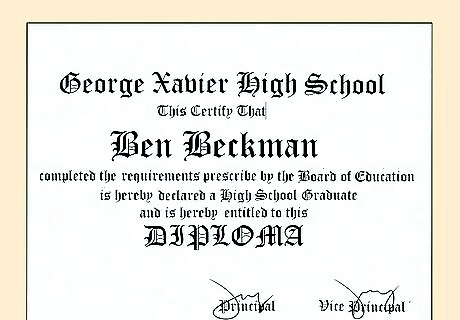
views
Training in Surgical Technology

Get a high school diploma or GED. A high school diploma or GED is required before you can start your surgical technology program. Unlike other medical fields, you do not need a bachelor’s degree first. While there are generally no prerequisites for starting this program, classes in biology, chemistry, and health may give you a good foundation for your studies.

Complete an accredited program in surgical technology. Accredited programs may either grant a certificate or an associate’s degree. Many community colleges and vocational schools offer surgical technology programs. An associate’s degree lasts two years while a certificate will only take a few months. While both will work, an associate’s degree may qualify you for more jobs. To see if a school is accredited, look it up in the Commission on Accreditation of Allied Health Education Programs’ database. Any accredited surgical technology program will offer hands-on experience. For this reason, online programs may not be accredited, as they will not be able to provide this training.

Join a military training program. Instead of a program at a school, you can get on-the-job training by joining the military. While the training is paid for by the military, you must sign up for service for a certain number of years. To join, contact your local military recruiting center. They will determine if you are eligible and put you in touch with the Medical Education and Training Campus (METC), where your training will begin. The US Air Force offers an apprenticeship in surgical services. This requires 624 hours of training. The US Army will train you as an operating room specialist. This program requires 768 hours of training. The US Navy has a program in surgical technology that requires 1057 hours.

Earn your CPR and BLS certifications. In addition to your degree, you may need to be certified in cardiopulmonary resuscitation (CPR) or basic life support (BLS). These programs may be offered as part of your education. You can also become certified at local schools, non-profits, community centers, and gyms. CPR certification usually lasts for two years. You will need to renew it after that point. BLS training teaches you how to respond to medical emergencies. BLS training sometimes includes CPR. Certification lasts two years.
Earning Your Certification

Decide which certification you will apply for. There are two different certifications that you can apply for. Each will qualify you for the job of surgical tech. Both require an exam and a fee. While both certifications are valuable, the certified tech in surgery is slightly cheaper while the certified surgical technologist certification is more widely known. The certified surgical technologist exam from the National Board of Surgical Technology and Surgical Assisting (NBSTSA) costs between $190 (for members of the Association of Surgical Technologists) and $290 (for non-members). The certified tech in surgery from the National Center for Competency Testing (NCCT) costs either $155 (for students and recent grads) or $195. You can join the Association of Surgical Technologists by filling out a form and paying a $80 fee on their website. This is not necessary to pass either exam, but it may provide a discount on exam fees.

Gather your documents. Before you can take the exam, you will need to provide proof of your training. If you went to an accredited school, this includes your transcripts and a copy of your diploma. If you received military training, you may need to provide a form filled out and signed by your supervisor.

Apply online or by mail. Both certification programs can be joined by either mailing in your application or submitting it online. Once the application is accepted, you will be given a test number, a testing center, and a date for the exam. If you are applying online, use the portals on the NBSTSA or NCCT website. Scan your documents into the computer, and upload them as PDFs. You can pay by card. If you are applying by mail, print out a copy of the application from their website. Make copies of your documents. Attach them to your application with a paper clip. Include a check for your exam.

Take the exam. Both exams are roughly four hours long. However, the programs differ in what type of questions they ask. You will need to bring a number 2 pencil and an ID to the exam with you. For the NBSTSA exam, you will answer 105 questions about operative care, including sterilization, machine operation, and patient transfer. Twenty questions will cover other duties such as testing equipment or talking to patients. There are also 50 basic science questions. The NCCT exam contains 135 questions about surgical care, including preparing a catheter, assisting with sutures, and operating machinery. The other 40 questions cover additional duties, such as how to inventory supplies or label samples.
Finding a Job

Prepare a resume. Your resume should list of all of your training, certification, and experience as a surgical technologist. If you have any other experience in medicine, be sure to mention it. Don’t forget to include your CPR or BLS certification as well. You may want to emphasize your attention to detail, strong stress management skills, and interpersonal skills. For example, you might write that you "excel when communicating with patients" or that you are "an effective multitasker."

Search job boards in your area. Check local job boards and career sites, such as Monster or Indeed, to see what surgical tech jobs are available in your area. In some cases, you can even apply for the job through these websites.

Inquire at local hospitals. The majority of surgical technologists are employed at hospitals. Try to identify all of the local hospitals in your area and see if they have any jobs open for surgical technologists. You may also have some luck looking for jobs at local medical practices and outpatient care centers.

Ace the interview. Most surgical technologist positions will ask for an interview before hiring. This interview will test your knowledge, interpersonal skills, and professionalism. They may ask you to describe a certain medical procedure. You should explain the procedure in as much detail as possible as well as what your role will be during the procedure. The interviewer may want to know how you will act in emergencies. Based on your training, explain the proper procedure for handling an emergency. The interviewer may be interested in personal details, such as why you want to become a surgical tech or how you handle stress. Use specific stories and anecdotes to illustrate your point. For example, you might explain how undergoing surgery made you appreciate the people working hard to heal you.

Update your certification once a year. Once you have a job as a surgical technologist, you will need to maintain your certification. You may be required to take up to 14 hours of continuing education courses a year and pay an annual membership fee. Re-certification generally costs about $77 for one certification and $104 for more than one.



















Comments
0 comment